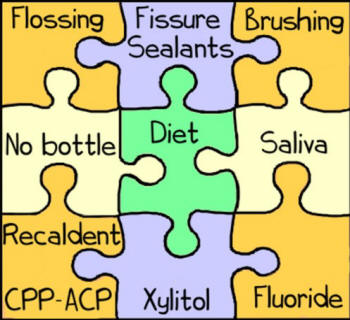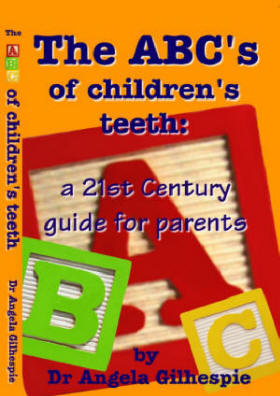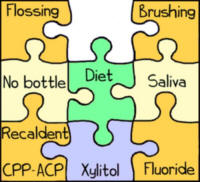The Preventative Jigsaw Puzzle

Omitting one of the puzzle pieces could result in a 'hole'.
No bottle
- Most parents are not aware that the bottle should be stopped by six months of age. The bottle is a feeding device, not a pacifier. Using it as a pacifier, with anything but boiled water, can have catastrophic consequences. The images in the book are testament to this. I can't believe that any mom will allow her child to go to sleep with a bottle after reading this book.
Diet
- Tooth decay is a disease of diet. This is why it is central to the jigsaw. The importance of a tooth-friendly diet and the timing of eating certain foods are explained in the section on diet. The reader is made aware of the link between sugar and tooth decay. Understanding the interaction between sugar and bacteria, you quickly see why it is important to control both the amount of high sugar foods and when they are consumed.
Brushing
- Most parents believe that brushing will prevent tooth decay for their children. The evidence is presented in the book why this is a misconception.
Flossing
- As soon as the a contact area between the back teeth is established the daily flossing routine should be in place. This occurs around 2 years. However, the earlier the flossing habit is started the better! Flossing handles make this process far easier for parents. This is explained in the section on 'Oral Care' in the book.
Sealants
- The importance for early sealing of the fissures of erupting teeth is well documented in the chapter on 'Fissure Sealants'. The reader is shown why baby and permanent teeth should be sealed. The inability of tooth brush bristles to penetrate the fissures explains why brushing is ineffectual in preventing fissure decay. Fissure sealants are one of the most powerful tools available for the prevention of tooth decay, yet it is probably the most under utilised preventative procedure.
Fluoride
- While fluoride is still an important element in the prevention of tooth decay, its limitations are discussed in the book.
Xylitol
- The is probably one of the most important 'newcomers' to the prevention family. The use of Xylitol, particularly in chewing gum, over a long period has been shown to significantly alter the bacteria of the mouth. This has now become an adjunct to brushing and flossing to reduce the bacterial levels in the mouth.
CCP-ACP (Recaldent)
- We refer to this as 'liquid enamel'. The GC tooth mousse concentrates calcium and phosphate minerals in a form for tooth repair. These minerals have been lost from the teeth during acid attacks.
Saliva
- After reading this chapter, you will change the way you think about saliva, or 'spit'. This is Nature's own defence against acid attack but, like our planet, it is in desperate need of help! The changes in our diets has resulted in the saliva being unable to cope with the high acid levels in our mouths. Think about fruit juices and cold drinks as acid mouthwashes, removing the minerals from our dental enamel and overwhelming the saliva's ability to neutralise these acid attacks. These attacks are just too intense and frequent for our saliva to have any effect. So think before you drink!
Copyright © Dr. A. Gilhespie 2008. All rights reserved.



